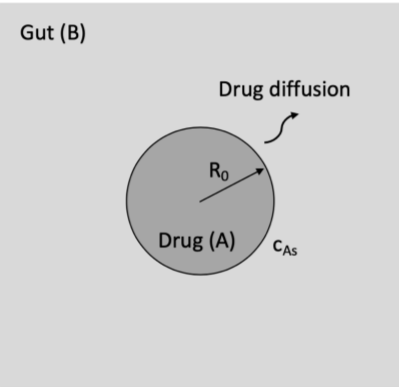Question
In pharmacology, we frequently wish to know how fast a particular medicine can permeate the body. This rate can be strongly influenced by physical and
In pharmacology, we frequently wish to know how fast a particular medicine can permeate the body. This rate can be strongly influenced by physical and chemical factors. For example, preparations of some antibiotics include detergents whose function is to increase the amount of drug dissolved in the gut. In other words, the detergent solubilizes the drug. Imagine taking such a pill. After a short time, the dissolution of this pill will reach a steady state, providing a steady flux of drug. We want to estimate the time required to produce this steady drug supply. The drugs dissolution is controlled by diffusion into the stagnant contents of the gut. Assume the pill is a sphere of drug (A) with a radius R0, and at t = 0 theres no drug outside the pill. At t > 0, the pill surface has a concentration cAs determined by equilibrium. The diffusivity of A in the gut (B) is DAB. Lets consider dilute diffusion only.
a. Starting from a shell mole balance, derive the mass transfer differential equation for A in B. Write the initial condition at t = 0 and boundary conditions at t > 0.
b. To solve the PDE in part a, its very useful to introduce a new variable as u = cA * r Simplify the PDE you derived in part (a) by substituting in the new variable u. What are the new initial and boundary conditions in terms of the new variable? Now, after you are finished with the part above, what does the equation look like in terms of the standard semi-infinite slab diffusion problem if you make an additional substitution that r* = r R0?
c. Derive the concentration profile with respect to time t and position r.
d. Calculate the molar flux of A at the surface (r = R0). How long will it take to decrease the time-dependent part in the flux to 10% of the steady-state flux, provide R0 = 3 mm and DAB = 10-5 cm2 /s?

Step by Step Solution
There are 3 Steps involved in it
Step: 1

Get Instant Access to Expert-Tailored Solutions
See step-by-step solutions with expert insights and AI powered tools for academic success
Step: 2

Step: 3

Ace Your Homework with AI
Get the answers you need in no time with our AI-driven, step-by-step assistance
Get Started


